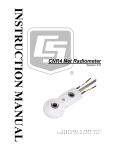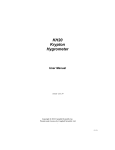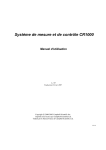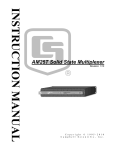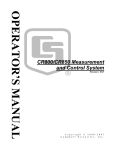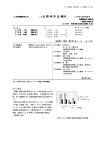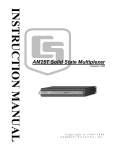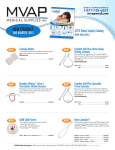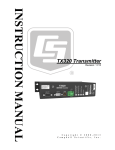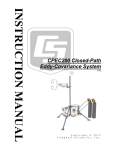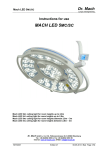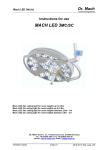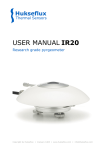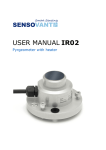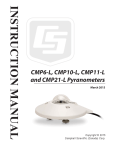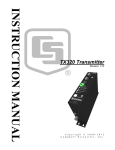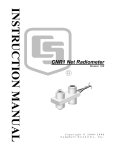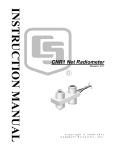Download Campbell CVF4 Specifications
Transcript
CNR4 Net Radiometer Revision: 11/10 C o p y r i g h t © 2 0 0 0 - 2 0 1 0 C a m p b e l l S c i e n t i f i c , I n c . Warranty and Assistance The CNR4 NET RADIOMETER is warranted by Campbell Scientific, Inc. to be free from defects in materials and workmanship under normal use and service for twelve (12) months from date of shipment unless specified otherwise. Batteries have no warranty. Campbell Scientific, Inc.'s obligation under this warranty is limited to repairing or replacing (at Campbell Scientific, Inc.'s option) defective products. The customer shall assume all costs of removing, reinstalling, and shipping defective products to Campbell Scientific, Inc. Campbell Scientific, Inc. will return such products by surface carrier prepaid. This warranty shall not apply to any Campbell Scientific, Inc. products which have been subjected to modification, misuse, neglect, accidents of nature, or shipping damage. This warranty is in lieu of all other warranties, expressed or implied, including warranties of merchantability or fitness for a particular purpose. Campbell Scientific, Inc. is not liable for special, indirect, incidental, or consequential damages. Products may not be returned without prior authorization. The following contact information is for US and International customers residing in countries served by Campbell Scientific, Inc. directly. Affiliate companies handle repairs for customers within their territories. Please visit www.campbellsci.com to determine which Campbell Scientific company serves your country. To obtain a Returned Materials Authorization (RMA), contact Campbell Scientific, Inc., phone (435) 753-2342. After an applications engineer determines the nature of the problem, an RMA number will be issued. Please write this number clearly on the outside of the shipping container. Campbell Scientific's shipping address is: CAMPBELL SCIENTIFIC, INC. RMA#_____ 815 West 1800 North Logan, Utah 84321-1784 For all returns, the customer must fill out a “Declaration of Hazardous Material and Decontamination” form and comply with the requirements specified in it. The form is available from our website at www.campbellsci.com/repair. A completed form must be either emailed to [email protected] or faxed to 435-750-9579. Campbell Scientific will not process any returns until we receive this form. If the form is not received within three days of product receipt or is incomplete, the product will be returned to the customer at the customer’s expense. Campbell Scientific reserves the right to refuse service on products that were exposed to contaminants that may cause health or safety concerns for our employees. CNR4 Table of Contents PDF viewers note: These page numbers refer to the printed version of this document. Use the Adobe Acrobat® bookmarks tab for links to specific sections. 1. General Description.....................................................1 2. Sensor Specifications .................................................2 2.1 2.2 2.3 2.4 CNR4 Specifications ................................................................................3 Pyranometer Specifications ......................................................................4 Pyrgeometer Specifications ......................................................................5 Optional CNF4 Heater/Ventilator.............................................................5 2.4.1 CNF4 Specifications .......................................................................6 3. Installation....................................................................6 4. Using the Optional CNF4 Heater/Ventilator Unit.......8 5. Using the CNR4 in the Four Separate Components Mode ...........................................................................9 5.1 5.2 5.3 5.4 5.5 5.6 5.7 Measuring Short-wave Solar Radiation with Pyranometer ......................9 Measuring Long-wave Far Infrared Radiation with Pyrgeometer ............9 Measuring CNR4 Temperature with Thermistor ....................................10 Calculation of Albedo.............................................................................12 Calculation of Net Short-wave Radiation...............................................13 Calculation of Net Long-wave Radiation ...............................................13 Calculation of Net (Total) Radiation ......................................................14 6. Wiring..........................................................................14 7. Datalogger Programming..........................................17 7.1 Sensor Sensitivity ...................................................................................17 7.2 Example Programs..................................................................................17 7.2.1 Example 1, CR1000 Program Using Differential Measurements .17 7.2.2 Example 2, CR3000 Program Using Differential Measurements .21 7.2.3 Example 3, CR5000 Program Using Differential Measurements .24 8. Troubleshooting ........................................................28 8.1 8.2 8.3 8.4 Testing the Pyranometer .........................................................................28 Testing the Pyrgeometer .........................................................................29 Testing the Thermistor............................................................................29 Testing the Pt-100...................................................................................29 i CNR4 Table of Contents 9. Maintenance and Recalibration ................................29 9.1 9.2 9.3 9.4 Cleaning Windows and Domes.............................................................. 29 Recalibration .......................................................................................... 30 Replacing the Drying Cartridge ............................................................. 30 Replacement Parts.................................................................................. 31 Appendices A. CNR4 Performance and Measurements under Different Conditions ............................................. A-1 B. CNF4 Heater/Ventilator ........................................... B-1 B.1 B.2 B.3 B.4 General Information ............................................................................ B-1 Attaching the Optional CNF4 Heater/Ventilator Unit to CNR4 ......... B-3 Wiring ................................................................................................. B-7 Example B, CR3000 Datalogger Program with Heater/Ventilator Control............................................................................................. B-8 B.5 CNF4 Heater/Ventilator Maintenance............................................... B-11 B.5.1 Testing the Heater.................................................................... B-11 B.5.2 Testing the Ventilator .............................................................. B-11 B.5.3 Replacing the Filter for the Ventilator..................................... B-12 C. CR3000 Program for Measuring Pt-100 Temperature Sensor.............................................C-1 Figures 2-1. 2-2. 3-1. 3-2. The CNR4 net radiometer with cables and mounting rod, top view ...... 2 The CNR4 net radiometer with CNF 4 heater/ventilator unit, top view. 2 Attaching the mounting rod to the CNR4 body...................................... 7 Attaching the CNR4 onto the mounting rod (CSI p/n 26120) using vertical pole or horizontal crossarm .................................................... 8 6-1. The CNR4 sensor with SOLAR and TEMP cables .............................. 14 6-2. The marks on the end of the CNR4: S for SOLAR cable, and T for TEMP cable....................................................................................... 15 6-3. Labels on the pigtail end of the SOLAR cable ..................................... 15 6-4. Labels on the pigtail end of the TEMP cable........................................ 16 9-1. Replacing the Drying Cartridge............................................................ 30 A-1. Different measurement conditions and signals .................................. A-2 A-2. Partly cloudy day for the upward facing pyrgeometer....................... A-2 A-3. Clear day for the downward facing pyrgeometer .............................. A-3 B-1. CNF4 Package Contents .................................................................... B-3 B-2. Attaching the CNF4 to CNR4 using pan-head screws and washers .. B-4 B-3. Making sure the cables are clear from the edges ............................... B-5 B-4. CNF4 solar shield and four flat-head screws ..................................... B-5 B-5. Attaching the solar shield to CNF4 using four flat-head screws........ B-6 B-6. Affixing the sensor label to CNF4 ..................................................... B-6 B-7. Connecting the CNF4 power control cable and the mounting rod..... B-6 ii CNR4 Table of Contents Tables 5-1. Resistance values versus CNR4's thermistor temperature in °C ...........11 5-2. Resistance values versus CNR4's Pt-100 temperature in °C .................12 6-1. Datalogger Connections for Differential Measurement ........................16 6-2. Datalogger Connections for Single-ended Measurement......................16 A-1. Typical output signals of CNR4 under different meteorological conditions. Explanation can be found in the text ........................... A-1 B-1. CR1000 and CR3000 Datalogger Connections for Differential Measurement with Heater/Ventilator Control..................................B-7 C-1. Datalogger Connections for Differential Measurement with Pt-100 ..C-1 iii CNR4 Table of Contents iv CNR4 Net Radiometer 1. General Description The CNR4 is a four component net radiometer that measures the energy balance between incoming and outgoing radiation. The CNR4 net radiometer consists of a pyranometer pair, one facing upward, the other facing downward, and a pyrgeometer pair in a similar configuration. The pyranometer pair measures short-wave solar radiation, and the pyrgeometer pair measures long-wave far infrared radiation. The upper longwave detector of CNR4 has a meniscus dome. This ensures that water droplets roll off easily and improves the field of view to nearly 180°, compared with a 150° for a flat window. All four sensors are integrated directly into the instrument body, instead of separate modules mounted onto the housing. Each sensor is calibrated individually for optimal accuracy. Two temperature sensors, a thermistor and a Pt-100, are integrated with the CNR4 body. The temperature sensor is used to provide information to correct the infrared readings for the temperature of the instrument housing. Care has been taken to place the long-wave sensors close to each other and close to the temperature sensors. This assures that the temperatures of the measurement surfaces are the same and accurately known. This improves the quality of the long-wave measurements. Campbell Scientific adds a completion resistor in the pig tail end of the thermistor cable, so that it is easily interfaced with our dataloggers for half-bridge measurement. The CNR4 design is very light in weight and has an integrated solar shield that reduces thermal effects on both the short-wave and the long-wave measurements. The cables are made from Santoprene® jacket, which is intended for outdoor use, and is resistant to a variety of pollutants and UVradiation. The mounting rod can be unscrewed for transport. An optional ventilation unit with a heater, CNF4, is designed as an extension of the solar shield and can be fitted new to the CNR4 or retrofitted later. The heater/ventilation unit is compact and provides efficient air-flow over the domes and windows to minimize the formation of dew and to reduce the frequency of cleaning. The integrated heater can be used to melt frost. The CNR4 specifications when used with CNF4 comply with the WMO classification of Good Quality. The CNR4 design is such that both the upward facing and the downwardfacing instruments measure the energy that is received from the whole hemisphere (180° field of view). The output is expressed in W/m2. The total spectral range that is measured is roughly from 0.3 to 42 μm. This spectral range covers both the short-wave solar radiation, 0.3 to 2.8 μm, and the longwave far infrared radiation, 4.5 to 42 μm. The gap between these two produces negligible errors. Unlike the CNR1, four probes in the CNR4 have different sensitivity values. This makes each measurement from four sensors more accurate than when they are made to have the same sensitivity value with shunt and series resistors. 1 CNR4 Net Radiometer 2. Sensor Specifications The CNR4 consists of two pyranometers, for measuring short-wave radiation, and of two pyrgeometers for measuring long-wave radiation. Two temperature sensors are available as standard, a thermistor and a Pt-100. The optional heater/ventilator unit CNF4-L is available. See Appendix B for more information on the CNF4-L. The properties of the CNR4 are mainly determined by the properties of the individual probes. Generally the accuracy of the CNR4 will be higher than that of competitive net-radiometers, because the solar radiation measurement performed by the pyranometer is accurate, and offers a traceable calibration. Also the optionally integrated heater/ventilator unit improves the accuracy. Due to the fact that the net short-wave radiation can be very intense, 1000 W/m2 compared to a typical -100 W/m2 net long-wave radiation, the accuracy of the short-wave radiation measurement is critical. Wind corrections, as applied by less accurate competitive instruments are not necessary. The robust materials used imply that the CNR4 will not suffer damages inflicted by birds. Figure 2-1 and Figure 2-2 show the CNR4 with and without the CNF4 heater/ventilator. From a spectral point of view, the pyranometer and pyrgeometer are complementary, and together they cover the full spectral range. FIGURE 2-1. The CNR4 net radiometer with cables and mounting rod, top view. FIGURE 2-2. The CNR4 net radiometer with CNF 4 heater/ventilator unit, top view. 2 CNR4 Net Radiometer 2.1 CNR4 Specifications Sensor sensitivities: Four probes have unique sensitivity values. Please refer to the calibration sheets or label on the bottom of the sensor for the sensitivity values. Operating temperature: -40 to +80°C (-40 to 176°F) Operating humidity: 0 to 100 % RH Bubble level sensitivity: < 0.5° Sensor type: Thermopile Receiver paint: Carbon Black Desiccant: Silica gel (replaceable) Housing material: Anodized aluminum body Shock/vibration: IEC 721-3-2-2m2 CE: Complies with EC guideline 89/336/EEC 73/23/EEC Environmental protection: IP 67 Requirements for data acquisition Radiation components: 4 differential or 4 single-ended analog channels Thermistor: 1 voltage excitation and 1 singleended analog channel Pt-100 temperature: 1 current excitation and 1 differential analog channel. Cable length: User defined Weight Sensor: 1.89 lbs (0.85 kg) without cables Heater/Ventilator, CNF4 (optional): 1.11 lbs (0.50 kg) without cables Mounting rod: CNR4 Package includes: 13.67 ” (34.7 cm) length 0.63 ” (1.6 cm) diameter CNR4 sensor Mounting rod (1 ea.) Solar cable (labeled SOLAR) Temperature cable (labeled TEMP) Drying cartridges (2 ea.) WRR Traceable Calibration Certificate for pyranometers WRR Traceable Calibration Certificate for pyrgeometers Extra Calibration Sticker (to be put on CNF4, if used) CNF4 Package includes: CNF4 Heater/Ventilator CNF4 cable 3 CNR4 Net Radiometer 2.2 Pyranometer Specifications * indicates ISO specifications. Spectral range: 305 to 2800 nm (50% points) Sensitivity: 10 to 20 µV/W/m2 Response time*: < 18 seconds (95% response) Non-linearity*: < 1% (0-1000 W m-2 irradiance) Non-stability*: < 1% Temperature dependence of sensitivity*: < 4% (-10° to +40°C) Tilt response*: < 1% at any angle with 1000 W/m2 Directional error*: < 20 W/m2 at angle up to 80° with 1000 W/m2 Zero offset due to 0 to -200 W/m2 IR net irradiance*: Zero offset due to temperature change*: Operating temperature: < 15 W/m2 < 3 W/m2 (5K/hr temperature change) < 1 W/m2 (with CVF 4 installed) -40°C to +80°C Field of view 4 Upper detector: 180° Lower detector: 150° (due to lower solar shield to prevent illumination at low zenith angles) Maximum solar irradiance: 2000 W/m2 Expected accuracy for daily totals: ±10 % Typical signal output for atmospheric application: 0 to 15 mV Impedance: 20 to 200 Ω, typically 50Ω Detector: Copper-constantan multi junction thermopile Level accuracy: 1 degree Irradiance: 0 to 2000 W/m2 Spectral selectivity: < 3% (330-1500 nm spectral interval) Uncertainty in daily total: < 5% (95% confidence level) Instrument calibration: Indoors. Side by side against reference CMP3 pyranometer according to ISO 9847:1992 annex A.3.1 CNR4 Net Radiometer 2.3 Pyrgeometer Specifications Spectral range: 4.5 μm to 42 μm (50% points) Sensitivity: 5 to 15 μV/W/m2 Impedance: 20 Ω to 200 Ω (typically 50) Response time: < 18 seconds (95% response) Non-linearity: < 1% (-250 to +250 W/m2 irradiance) Temperature dependence of sensitivity: < 4% (-10° to +40°C) Tilt error: Zero offset due to temperature change: < 1% (deviation when tilted at any angle off horizontal) ±4 W/m2 (5K/hr temperature change) Field of view Upper 180 degrees Lower 150 degrees Net-irradiance: -250 to +250 W/m2 Non-stability: < 1% (sensitivity change per year) Window heating offset: < 6 W/m2 (1000 W/m2 solar irradiance) Uncertainty in daily total: < 10% (95% confidence level) indoor calibration Typical signal output for atmospheric application: ±5 mV Temperature sensors Thermistor: 10k Ω Pt-100: DIN class A Instrument calibration: Indoors, side by side against reference CG(R) 3 pyrgeometer. On request outdoors, side by side against reference CG(R) 4 pyrgeometer 2.4 Optional CNF4 Heater/Ventilator The purpose of the heater/ventilator is to prevent dew deposition on the pyrgeometer and pyrgeometer window, thus enhancing the measurement accuracy and reliability. Using the heater/ventilator will have negligible effect on the pyranometer reading. Generally, the errors caused by the heater/ventilator will be small relative to the errors that would have been caused by water deposition. 5 CNR4 Net Radiometer 2.4.1 CNF4 Specifications Heater Power consumption: 10 W @ 12 Vdc (15 Ω) Ventilator Power consumption: 5 W @ 12 Vdc Supply voltage: 8 to 13.5 Vdc Weight: 1.11 lbs (0.5 kg) Operating temperature: -40 to +80°C 3. Installation For measurement of net radiation, it is most important that the instrument is located in a place that is representative of the entire area that one wishes to study. When installed on a mast, the preferred orientation should be such that no shadow is cast on the net radiometer at any time during the day. In the Northern Hemisphere this implies that the net radiometer should be mounted on the south side of the mast. It is suggested that the CNR4 is mounted at a height of at least 1.5 meters above the surface to avoid shading effects of the instruments on the soil and to promote spatial averaging of the measurement. If the instrument is h meters above the surface, 99% of the input of the lower sensors comes from a circular area with a radius of 10h. Shadows or surface disturbances with radius < 0.1h will affect the measurement by less than 1%. It is recommended that the CNR4 be mounted to a separate vertical pipe at least 25 feet from any other mounting structures. The mounting bracket (CSI p/n 26120) is used to mount the CNR4 directly to a vertical pipe, or to a CM20x series Sensor Crossarm. Mount the sensor as follows: 6 1. First, attach the mounting rod to the CNR4, as shown in Figure 3-1. 2. Attach mounting bracket (CSI p/n 26120) to the vertical mounting pipe or CM20x series Sensor Crossarm, using the U-bolts provided as shown in Figure 3-2. 3. Insert the mounting rod of the CNR4 sensor into a mounting block of the mounting bracket (CSI p/n 26120), making sure the sensor points to the direction of the arrows marked as “SENSOR” on top of the bracket (see Figure 3-2). Perform a coarse levelling of the sensor using the bubble level on the top of the CNR4, and tighten the four screws on top of the mounting bracket to properly secure the mounting rod so that it does not rotate. CNR4 Net Radiometer NOTE Do not attempt to rotate the instrument using the sensor heads, or you may damage the sensors; use the mounting rod only. 4. Perform the fine levelling using the two spring-loaded levelling screws: one on the front and the other on the back of the bracket. FIGURE 3-1. Attaching the mounting rod to the CNR4 body. 7 CNR4 Net Radiometer FIGURE 3-2. Attaching the CNR4 onto the mounting rod (CSI p/n 26120) using vertical pole or horizontal crossarm. For installation in buildings or in solar energy applications, one will often have to mount the CNR4 parallel to the surface that is being studied. This may be in a tilted or a vertical position. The sensitivity of the radiometers will be affected, but only in a minor way. This is specified as the so-called tilt effect. From the specifications one can see that the tilt effect (this is a change in sensitivity) remains within 1 % (See specifications in Section 2). 4. Using the Optional CNF4 Heater/Ventilator Unit The optional heater/ventilator unit for CNR4 is available from the manufacturer. You can purchase the CNF4-L heater/ventilator from Campbell Scientific with custom cable length. Please refer to the Appendix B for details on the CNF4 heater/ventilator, including the assembling instructions and sample programs to control the CNF4 unit. 8 CNR4 Net Radiometer 5. Using the CNR4 in the Four Separate Components Mode In the four separate components mode configuration (measuring two shortwave radiation signals, two long-wave signals), all signals are measured separately. Calculation of net-radiation and albedo can be done on-line by the datalogger, or off-line by the user during post-processing, using the stored raw data. The two pyranometers will measure the short-wave radiation, both incoming and reflected. The two pyrgeometers will measure the long-wave radiation. For proper analysis of the pyrgeometer measurement results, they must be temperature corrected using the temperature measurement performed by the onboard thermistor or Pt-100 sensor. The following paragraphs describe how one should treat the instrument, and how different parameters like albedo, net short-wave radiation, net long-wave radiation, soil temperature, sky temperature, and net (total) radiation can be calculated. 5.1 Measuring Short-wave Solar Radiation with Pyranometer The pyranometer generates an mV signal that is simply proportional to the incoming short-wave radiation. The conversion factor between voltage, V, and W/m2 of solar irradiance E, is the so-called calibration constant C (or sensitivity). For each pyranometer E = V/C (5-1) Measuring with a pyranometer can be done by connecting two pyranometer wires to a datalogger. Incidental light results in a positive signal. The pyranometer mounting plate and ambient air should be at the same temperature, as much as possible. Conversion of the voltage to irradiance can be done according to equation 5-1, and this is done inside the datalogger program. With the upward-facing pyranometer the so-called global (solar) downwelling radiation is measured. The downward-facing pyranometer measures the reflected upwelling solar radiation. When calculating the net radiation, the upwelling radiation must be subtracted from the downwelling radiation. See Section 5.5. 5.2 Measuring Long-wave Far Infrared Radiation with Pyrgeometer When using the pyrgeometer, you should realize that the signal that is generated by the pyrgeometer represents the exchange of long-wave far infrared (thermal) radiation between the pyrgeometer and the object that it is facing. This implies that the pyrgeometer will generate a positive voltage output, V, when it faces an object that is hotter than its own sensor housing, and that it will give a negative voltage signal when it faces an object that is 9 CNR4 Net Radiometer colder. This means that for estimating the far infrared radiation that is generated by the object that is faced by the pyrgeometer, usually the sky or the soil, you will have to take the pyrgeometer temperature, T, into account. This is why the temperature sensors are incorporated in the CNR4's body near the pyrgeometer sensing element, and has, therefore, the same temperature as the pyrgeometer sensor surface. The calculation of the long-wave far infrared irradiance, E, is done according to the following equation: For the pyrgeometer only E = V/C + 5.67·10-8·T4 (5-2) In this equation C is the sensitivity of the sensor. Please bear in mind that T is in Kelvin, and not in Celsius or Fahrenheit. The downward-facing pyrgeometer measures the far infrared radiation that is emitted by the ground. The upward-facing pyrgeometer measures the far infrared radiation from the sky. As the sky is typically colder than the instrument, one can expect negative voltage signals from the upward-facing pyrgeometer. The Equation 5-2 is used to calculate the far infrared irradiance of the sky and of the ground. 5.3 Measuring CNR4 Temperature with Thermistor The CNR4 has two temperature sensors built inside: thermistor and Pt-100. They both have the identical accuracy. We recommend using the thermistor with Campbell Scientific dataloggers. The thermistor has a larger resistance (10 kΩ @ 25°C) than Pt-100 sensor (100 Ω @ 0°C), and the change in resistance with respect to temperature, in absolute terms, is greater. Therefore, the cable resistance can be neglected, and the thermistor can easily be measured using half-bridge measurement instruction on Campbell Scientific dataloggers. This makes it simpler to program, and uses fewer measurement channels. Table 5-1 shows the thermistor resistance values as a function of temperature. Relatively small errors occur when the CNR4 is not in thermal equilibrium. This happens for example when the heater is on, or when the sun is shining. When the heater and ventilator are on, the largest expected deviation between the real sensor temperature and the thermistor reading is 1 degree. This results in a worst case error for the pyrgeometer of 5 W/m2. When the sun is shining, the largest expected deviation between the real sensor temperature and the thermistor reading is again 1 degree. This results in a worst case error for the pyrgeometer of 5 W/m2. The thermistor will not give a good indication of ambient air temperature; at 1000 W/m2 solar radiation, and no wind, the instrument temperature will rise approximately 5 degrees above the ambient temperature. The offsets of both the pyranometers and the pyrgeometers might be larger than 5W/m2 if large temperature gradients are forced on the instrument (larger than 5 K/hr). This happens for example when rain hits the instrument. The occurrence of this can be detected using the thermistor readout, and can be used for data filtering. 10 CNR4 Net Radiometer The thermistor measurement can be done by the datalogger, using the half bridge measurement method which requires one voltage excitation and one single-ended analog channel. Alternatively, you can use the Pt-100 to make the temperature measurement. In order to make the temperature measurement, using the Pt-100 sensor, you will need one current excitation channel, and one differential analog channel. Please refer to Appendix C for a sample program to measure Pt-100. TABLE 5-1. Resistance values versus CNR4's thermistor temperature in °C. Temperature [°C] Resistance [Ω] Temperature [°C] Resistance [Ω] Temperature [°C] Resistance [Ω] -30 -29 -28 -27 -26 -25 -24 -23 -22 -21 -20 -19 -18 -17 -16 -15 -14 -13 -12 -11 -10 -9 -8 -7 -6 -5 -4 -3 -2 -1 135200 127900 121100 114600 108600 102900 97490 92430 87660 83160 78910 74910 71130 67570 64200 61020 58010 55170 52480 49940 47540 45270 43110 41070 39140 37310 35570 33930 32370 30890 0 1 2 3 4 5 6 7 8 9 10 11 12 13 14 15 16 17 18 19 20 21 22 23 24 25 26 27 28 29 29490 28150 26890 25690 24550 23460 22430 21450 20520 19630 18790 17980 17220 16490 15790 15130 14500 13900 13330 12790 12260 11770 11290 10840 10410 10000 9605 9227 8867 8523 30 31 32 33 34 35 36 37 38 39 40 41 42 43 44 45 46 47 48 49 50 51 52 53 54 55 56 57 58 59 8194 7880 7579 7291 7016 6752 6500 6258 6026 5805 5592 5389 5193 5006 4827 4655 4489 4331 4179 4033 3893 3758 3629 3504 3385 3270 3160 3054 2952 2854 11 CNR4 Net Radiometer TABLE 5-2. Resistance values versus CNR4's Pt-100 temperature in °C. Temperature [°C] -30 -29 -28 -27 -26 -25 -24 -23 -22 -21 -20 -19 -18 -17 -16 -15 -14 -13 -12 -11 -10 -9 -8 -7 -6 -5 -4 -3 -2 -1 Resistance [Ω] 88.22 88.62 89.01 89.40 89.80 90.19 90.59 90.98 91.37 91.77 92.16 92.55 92.95 93.34 93.73 94.12 94.52 94.91 95.30 95.69 96.09 96.48 96.87 97.26 97.65 98.04 98.44 98.83 99.22 99.61 Temperature [°C] 0 1 2 3 4 5 6 7 8 9 10 11 12 13 14 15 16 17 18 19 20 21 22 23 24 25 26 27 28 29 Resistance [Ω] 100.00 100.39 100.78 101.17 101.56 101.95 102.34 102.73 103.12 103.51 103.90 104.29 104.68 105.07 105.46 105.85 106.24 106.63 107.02 107.40 107.79 108.18 108.57 108.96 109.35 109.73 110.12 110.51 110.90 111.28 Temperature [°C] 30 31 32 33 34 35 36 37 38 39 40 41 42 43 44 45 46 47 48 49 50 51 52 53 54 55 56 57 58 59 Resistance [Ω] 111.67 112.06 112.45 112.83 113.22 113.61 113.99 114.38 114.77 115.15 115.54 115.93 116.31 116.70 117.08 117.47 117.85 118.24 118.62 119.01 119.40 119.78 120.16 120.55 120.93 121.32 121.70 122.09 122.47 122.86 5.4 Calculation of Albedo Albedo is the ratio of reflected short-wave radiation to incoming short-wave radiation. This unitless value ranges between 0 and 1. Typical values are 0.9 for snow, and 0.3 for grassland. To determine the albedo, the measured values of the two pyranometers can be used. The pyrgeometers are not involved, as they do not measure short-wave solar radiation. Do not use the measured values when the solar elevation is lower than 10 degrees above the horizon. Errors in the measurements at these elevations are likely and yield unreliable results. This is due to deviations in the directional response of the pyranometers. Albedo = (E lower Pyranometer) / (E upper Pyranometer) 12 (5-3) CNR4 Net Radiometer In the equation above, E is calculated according to the Equation 5-1. Albedo will always be smaller than 1. Checking this can be used as a tool for quality assurance of your data. If you know the approximate albedo at your site, the calculation of albedo can also serve as a tool for quality control of your measured data at a specific site. 5.5 Calculation of Net Short-wave Radiation The net short-wave solar radiation is equal to the incoming (downwelling) short-wave radiation minus the reflected (upwelling) short-wave radiation. Net Short-wave Radiation = (E upper Pyranometer) - (E lower Pyranometer) (5-4) In the equation above, E is calculated according to Equation 5-1. Net short-wave solar radiation will always be positive. This can be used as a tool for quality assurance of your measured data. 5.6 Calculation of Net Long-wave Radiation The net long-wave far Infrared radiation is the part that contributes to heating or cooling of the earth's surface. In practice, usually the net long-wave far infrared radiation will be negative. Net Long-wave Radiation = (E upper Pyrgeometer) - (E lower Pyrgeometer) (5-5) In the equation above, E is calculated according to Equation 5-2. According to equation 5-5 above, the terms that contain the sensor body temperature T cancel each other. Therefore, if one is only interested in the net long-wave radiation, instead of separate upper and lower components of the long-wave radiation, the CNR4 temperature measurement is not required. The E measured with the pyrgeometer actually represents the irradiance of the sky (for upward- facing pyrgeometer) or the ground (for downward-facing pyrgeometer). Assuming that these two, ground and sky, behave like perfect blackbodies, theoretically, one can calculate an effective "Sky temperature" and an effective "Ground temperature". ⎡ E upper Pyrgeometer ⎤ Sky temperature = ⎢ ⎥ 5.67 ⋅ 10 −8 ⎣ ⎦ 1/ 4 ⎡ E lower Pyrgeometer ⎤ Ground Temperature = ⎢ ⎥ 5.67 ⋅ 10 −8 ⎣ ⎦ (5-6) 1/ 4 (5-7) As a rule of thumb, for ambient temperatures of about 20 degrees Celsius, one can say that one degree of temperature difference between two objects results in a 5 W/m2 exchange of radiative energy (infinite objects): 1 degree of temperature difference = 5 W/m2 (rule of thumb) 13 CNR4 Net Radiometer 5.7 Calculation of Net (Total) Radiation In the four separate components mode, net radiation, Rn, can be calculated using the individual sensor measurement results: Rn = {(E upper Pyranometer) - (E lower Pyranometer)} + {(E upper Pyrgeometer) - (E lower Pyrgeometer)} (5-8) Where E upper/lower pyranometers are calculated according to Equation 5-1, and E upper/lower pyrgeometers are calculated according to Equation 5-2. The terms with T cancel each other out. 6. Wiring The CNR4 has two outputs for short-wave radiation, two outputs for long-wave radiation, thermistor output, and Pt-100 temperature sensor output. In addition, if a user chooses to attach the optional CNF4 heater/ventilator unit, it will have power wires for heater and ventilator. All wiring schemes shown in this manual and the sample programs will use the thermistor for the temperature measurement of the CNR4. The wiring diagrams for the thermistor in this manual is applicable only if the CNR4 and the cables were purchased from Campbell Scientific, Inc. The CNR4 comes with two sets of cables labelled SOLAR and TEMP, as shown in Figure 6-1. Figure 6-2 shows the marks by the connecting ports at the sensor’s end for the cable connection: S and T for SOLAR and TEMP cables, respectively. The two cables, SOLAR and TEMP, have identical connectors, and care should be used to make sure that the correct cables are connected to the correct ports of the sensor. FIGURE 6-1. The CNR4 sensor with SOLAR and TEMP cables. 14 CNR4 Net Radiometer FIGURE 6-2. The marks on the end of the CNR4: S for SOLAR cable, and T for TEMP cable. The measurement details for Pt-100 sensor, including the wiring diagram and sample program are explained in the Appendix C of this manual. The four radiation outputs can be measured using differential or single-ended inputs on the datalogger. A differential voltage measurement is recommended because it has better noise rejection than a single-ended measurement. NOTE When differential inputs are used, jumper the low side of the input to AG or to keep the signal in common mode range. The Tables 6-1 and 6-2 show the wiring instructions for the differential measurement and single-ended measurement connections to the datalogger, respectively. The cables have the white band at the pigtail end of the cable with the color keys. See the Figure 6-3 and 6-4 below for the labels on the cable for both the SOLAR and TEMP cables. FIGURE 6-3. Labels on the pigtail end of the SOLAR cable. 15 CNR4 Net Radiometer FIGURE 6-4. Labels on the pigtail end of the TEMP cable. TABLE 6-1. Datalogger Connections for Differential Measurement Function Pyranometer Up Signal Pyranometer Up Reference Pyranometer Down Signal Pyranometer Down Reference Pyrgeometer Up Signal Pyrgeometer Up Reference Pyrgeometer Down Signal Pyrgeometer Down Reference Shield Wire Color Red *Blue White *Black Grey *Yellow Brown *Green Clear CR1000 Differential Input (H) Differential Input (L) Differential Input (H) Differential Input (L) Differential Input (H) Differential Input (L) Differential Input (H) Differential Input (L) CR3000/CR5000 Differential Input (H) Differential Input (L) Differential Input (H) Differential Input (L) Differential Input (H) Differential Input (L) Differential Input (H) Differential Input (L) Thermistor Signal Thermistor Voltage Excitation Thermistor Signal Reference Shield White Red Black Clear Single-ended Input Voltage Excitation (VX) Single-ended Input Voltage Excitation (VX) *Jumper to with user supplied wire. TABLE 6-2. Datalogger Connections for Single-ended Measurement Function Pyranometer Up Signal Pyranometer Up Reference Pyranometer Down Signal Pyranometer Down Reference Pyrgeometer Up Signal Pyrgeometer Up Reference Pyrgeometer Down Signal Pyrgeometer Down Reference Shield Wire Color Red Blue White Black Grey Yellow Brown Green Clear Thermistor Signal Thermistor Voltage Excitation Thermistor Signal Reference Shield White Red Black Clear CR1000 Single-Ended Input CR3000/CR5000 Single-Ended Input Single-Ended Input Single-Ended Input Single-Ended Input Single-Ended Input Single-Ended Input Single-Ended Input Single-ended Input Voltage Excitation (VX) Single-ended Input Voltage Excitation (VX) *Pull back wires for Pt-100 (grey, brown, green, and yellow), which are not in use, and tie them around the TEMP cable using a cable tie or electrical tape to avoid possible damage to the Pt-100, due to electrical short circuit. 16 CNR4 Net Radiometer 7. Datalogger Programming The CNR4 outputs four voltages that typically range from 0 to 15 mV for the pyranometers, and ± 5 mV for the pyrgeometers. A differential voltage measurement is recommended because it has better noise rejection than a single-ended measurement. If differential channels are not available, singleended measurements can be used. The acceptability of a single-ended measurement can be determined by simply comparing the results of singleended and differential measurements made under the same conditions. Additionally, one voltage excitation channel and one single-ended analog channel are required to make the temperature measurement of the sensor body, using the thermistor. 7.1 Sensor Sensitivity Unlike the CNR1, the CNR4 comes with four different sensor sensitivity values for four separate probes. The CNR4 sensor comes with two copies of ‘Certificate of Calibration’ by the manufacturer. They show the sensor serial number and sensitivity values for four individual probes: one copy for pyranometers, and another copy for pyrgeometers. The serial number and sensitivity values are also shown on a label affixed to the bottom of the sensor. If you choose to attach the CNF4, heater/ventilator unit to the CNR4, this label showing the serial number and sensitivity values will be covered. After attaching the CNF4 heater/ventilator, make sure to affix the extra label to the bottom of the CNF4, heater/ventilator unit so that you will have the label on a visible location. The extra label containing the serial number and sensitivity values is supplied with the purchase of the CNR4. Please refer to the Appendix B for more details. The sensor sensitivity is in the units of μV/(W/m2). This needs to be converted into the units of (W/m2)/mV to be used as a multiplier parameter inside the datalogger program. To convert the units, divide the sensor sensitivity value into 1000. For example, if the sensitivity is 7.30 μV/(W/m2), the multiplier is 1000/7.3 = 136.99 (W/m2)/mV. 7.2 Example Programs 7.2.1 Example 1, CR1000 Program Using Differential Measurements The Program Example 1 requires four differential channels to measure the four radiation outputs and one excitation channel and one single-ended channel to measure the thermistor. The program measures the sensors every 1 second, performs the on-line processing of the data and stores the following processed data to a data table called cnr4_data once every 60 minutes. It also stores the raw time-series data from CNR4 to data table called cnr4_ts. Minimum Battery voltage Sample Datalogger panel temperature Average Short-wave radiation (pyranometer up) Average Short-wave radiation (pyranometer down) Average Long-wave radiation (pyrgeometer up) Average Long-wave radiation (pyrgeometer down) Average CNR4 thermistor temperature (degrees C) Average CNR4 thermistor temperature (Kelvin) 17 CNR4 Net Radiometer Average Corrected long-wave radiation (pyrgeometer up) Average Corrected long-wave radiation (pyrgeometer down) Average Short-wave net radiation Average Long-wave net radiation Average Albedo Average Net radiation 'CR1000 Series Datalogger ' 'CNR4 program 'This program measures CNR4 four-component net radiometer 'This program also measures the thermistor inside the CNR4 ' 'User must enter the sensitivity values for all four probes in the program and save/compile 'prior to downloading it to the datalogger. 'Search for the text string "unique" to find places to enter the sensitivity values. ' 'Wiring Instructions ' 'ANALOG CHANNELS '1H CNR4 Pyranometer Upper signal (red) '1L CNR4 Pyranometer Upper signal reference (blue) 'gnd jumper to 1L ' '2H CNR4 Pyranometer Lower signal (white) '2L CNR4 Pyranometer Lower signal reference (black) 'gnd jumper to 2L ' '3H CNR4 Pyrgeometer Upper signal (grey) '3L CNR4 Pyrgeometer Upper signal reference (yellow) 'gnd jumper to 3L ' '4H CNR4 Pyrgeometer Lower signal (brown) '4L CNR4 Pyrgeometer Lower signal reference (green) 'gnd jumper to 4L ' CNR4 shield (clear) ' ' ' '8H '8L CNR4 thermistor signal (white) 'gnd CNR4 thermistor signal reference (black) ' CNR4 thermistor shield (clear) ' 'VOLTAGE EXCITATION ' 'EX2 CNR4 thermistor voltage excitation (red) ' 'CNR4 sensor Public logger_temp, batt_volt Public cnr4(4) Alias cnr4(1) = short_up Alias cnr4(2) = short_dn Alias cnr4(3) = long_up Alias cnr4(4) = long_dn 18 CNR4 Net Radiometer Public cnr4_T_C Public cnr4_T_K Public long_up_corr Public long_dn_corr Public Rs_net Public Rl_net Public albedo Public Rn 'CNR4 thermistor temperature in Celcius 'CNR4 thermistor temperature in Kelvin 'Downwelling long-wave radiation with temperature correction 'Upwelling long-wave radiation with temperature correction 'short-wave net radiation 'long-wave net radiation 'Albedo 'total net radiation Units logger_temp = degC Units batt_volt = volts Units short_up = W/m^2 Units short_dn = W/m^2 Units long_up = W/m^2 Units long_dn = W/m^2 Units cnr4_T_C = deg_C Units cnr4_T_K = K Units long_up_corr = W/m^2 Units long_dn_corr = W/m^2 Units Rs_net = W/m^2 Units Rl_net = W/m^2 Units albedo = W/m^2 Units Rn = W/m^2 Dim Rs, Vs_Vx 'CNR4 sensitivities: refer to the Certificate of Calibration from Kipp & Zonen for sensitivity values 'for each probes, and enter them below. Const pyranometer_up_sensitivity = 15.35 'unique sensitivity for upper pyranometer '(microV/W/m^2) Const pyranometer_dn_sensitivity = 15.41 'unique sensitivity for lower pyranometer '(microV/W/m^2) Const pyrgeometer_up_sensitivity = 8.50 'unique sensitivity for upper pyrgeometer '(microV/W/m^2) Const pyrgeometer_dn_sensitivity = 7.09 'unique sensitivity for lower pyrgeometer '(microV/W/m^2) 'CNR4 multipliers Public cnr4_mult(4) Const pyranometer_up_mult = 1000/pyranometer_up_sensitivity Const pyranometer_dn_mult = 1000/pyranometer_dn_sensitivity Const pyrgeometer_up_mult = 1000/pyrgeometer_up_sensitivity Const pyrgeometer_dn_mult = 1000/pyrgeometer_dn_sensitivity '(W/m^2/mV) '(W/m^2/mV) '(W/m^2/mV) '(W/m^2/mV) DataTable (cnr4_data,True,-1) DataInterval (0,60,Min,10) CardOut (1,-1) Minimum (1,batt_volt,FP2,0,False) Sample (1,logger_temp,FP2) Average (4,cnr4(1),IEEE4,False) Average (1,cnr4_T_C,IEEE4,False) Average (1,cnr4_T_K,IEEE4,False) Average (1,long_up_corr,IEEE4,False) Average (1,long_dn_corr,IEEE4,False) Average (1,Rs_net,IEEE4,False) 19 CNR4 Net Radiometer Average (1,Rl_net,IEEE4,False) Average (1,albedo,IEEE4,False) Average (1,Rn,IEEE4,False) EndTable DataTable (cnr4_ts,True,-1) DataInterval (0,1,Sec,10) CardOut (1,-1) Sample (4,cnr4(1),IEEE4) Sample (1,cnr4_T_K,IEEE4) EndTable BeginProg 'Load the multiplier values for the CNR4 cnr4_mult(1) = pyranometer_up_mult cnr4_mult(2) = pyranometer_dn_mult cnr4_mult(3) = pyrgeometer_up_mult cnr4_mult(4) = pyrgeometer_dn_mult Scan (1,Sec,3,0) PanelTemp (logger_temp,250) Battery (batt_volt) 'CNR4 radiation measurements VoltDiff (cnr4(1),4,mV25C,1,True ,0,_60Hz,cnr4_mult(1),0) 'CNR4 thermistor measurement BrHalf (Vs_Vx,1,mV2500,16,Vx2,1,2500,True ,0,250,1.0,0) Rs = 1000*(Vs_Vx/(1-Vs_Vx)) cnr4_T_C = 1/(1.0295e-3+2.391e-4*LN(Rs)+1.568e-7*(LN(Rs))^3)-273.15 'Convert CNR4 temperature to Kelvin cnr4_T_K = cnr4_T_C+273.15 'Correct the long-wave radiation values from pyrgeometers long_up_corr = long_up+5.67e-8*cnr4_T_K^4 long_dn_corr = long_dn+5.67e-8*cnr4_T_K^4 'Compute short-wave net radiation Rs_net = short_up - short_dn 'Compute long-wave net radiation Rl_net = long_up - long_dn 'Compute albedo albedo = short_dn/short_up 'Compute net radiation Rn = Rs_net + Rl_net CallTable cnr4_data CallTable cnr4_ts NextScan EndProg 20 CNR4 Net Radiometer 7.2.2 Example 2, CR3000 Program Using Differential Measurements The Program Example 2 requires four differential channels to measure the four radiation outputs and one excitation channel and one single-ended channel to measure the thermistor. The program measures the sensors every 1 second, performs the on-line processing of the data and stores the following processed data to a data table called cnr4_data once every 60 minutes. It also stores the raw time-series data from CNR4 to data table called cnr4_ts. Minimum Battery voltage Sample Datalogger panel temperature Average Short-wave radiation (pyranometer up) Average Short-wave radiation (pyranometer down) Average Long-wave radiation (pyrgeometer up) Average Long-wave radiation (pyrgeometer down) Average CNR4 thermistor temperature (degrees C) Average CNR4 thermistor temperature (Kelvin) Average Corrected long-wave radiation (pyrgeometer up) Average Corrected long-wave radiation (pyrgeometer down) Average Short-wave net radiation Average Long-wave net radiation Average Albedo Average Net radiation 'CR3000 Series Datalogger ' 'CNR4 program 'This program measures CNR4 four-component net radiometer 'This program also measures the thermistor inside the CNR4 ' 'User must enter the sensitivity values for all four probes in the program and save/compile 'prior to downloading it to the datalogger. 'Search for the text string "unique" to find places to enter the sensitivity values. ' 'Wiring Instructions ' 'ANALOG CHANNELS '1H CNR4 Pyranometer Upper signal (red) '1L CNR4 Pyranometer Upper signal reference (blue) 'gnd jumper to 1L ' '2H CNR4 Pyranometer Lower signal (white) '2L CNR4 Pyranometer Lower signal reference (black) 'gnd jumnper to 2L ' '3H CNR4 Pyrgeometer Upper signal (grey) '3L CNR4 Pyrgeometer Upper signal reference (yellow) 'gnd jumper to 3L ' '4H CNR4 Pyrgeometer Lower signal (brown) '4L CNR4 Pyrgeometer Lower signal reference (green) 'gnd jumper to 4L ' CNR4 shield (clear) ' ' 21 CNR4 Net Radiometer '8H '8L CNR4 thermistor signal (white) 'gnd CNR4 thermistor signal reference (black) ' CNR4 thermistor shield (clear) ' 'VOLTAGE EXCITATION ' 'VX1 CNR4 thermistor voltage excitation (red) ' 'CNR4 sensor Public logger_temp, batt_volt Public cnr4(4) Alias cnr4(1) = short_up Alias cnr4(2) = short_dn Alias cnr4(3) = long_up Alias cnr4(4) = long_dn Public cnr4_T_C Public cnr4_T_K Public long_up_corr Public long_dn_corr Public Rs_net Public Rl_net Public albedo Public Rn 'CNR4 thermistor temperature in Celcius 'CNR4 thermistor temperature in Kelvin 'Downwelling long-wave radiation with temperature correction 'Upwelling long-wave radiation with temperature correction 'short-wave net radiation 'long-wave net radiation 'Albedo 'total net radiation Units logger_temp = degC Units batt_volt = volts Units short_up = W/m^2 Units short_dn = W/m^2 Units long_up = W/m^2 Units long_dn = W/m^2 Units cnr4_T_C = deg_C Units cnr4_T_K = K Units long_up_corr = W/m^2 Units long_dn_corr = W/m^2 Units Rs_net = W/m^2 Units Rl_net = W/m^2 Units albedo = W/m^2 Units Rn = W/m^2 Dim Rs, Vs_Vx 'CNR4 sensitivities: refer to the Certificate of Calibration from Kipp & Zonen for sensitivity values 'for each probes, and enter them below. Const pyranometer_up_sensitivity = 15.35 'unique sensitivity for upper pyranometer '(microV/W/m^2) Const pyranometer_dn_sensitivity = 15.41 'unique sensitivity for lower pyranometer '(microV/W/m^2) Const pyrgeometer_up_sensitivity = 8.50 'unique sensitivity for upper pyrgeometer '(microV/W/m^2) Const pyrgeometer_dn_sensitivity = 7.09 'unique sensitivity for lower pyrgeometer '(microV/W/m^2) 22 CNR4 Net Radiometer 'CNR4 multipliers Public cnr4_mult(4) Const pyranometer_up_mult = 1000/pyranometer_up_sensitivity Const pyranometer_dn_mult = 1000/pyranometer_dn_sensitivity Const pyrgeometer_up_mult = 1000/pyrgeometer_up_sensitivity Const pyrgeometer_dn_mult = 1000/pyrgeometer_dn_sensitivity '(W/m^2/mV) '(W/m^2/mV) '(W/m^2/mV) '(W/m^2/mV) DataTable (cnr4_data,True,-1) DataInterval (0,60,Min,10) CardOut (1,-1) Minimum (1,batt_volt,FP2,0,False) Sample (1,logger_temp,FP2) Average (4,cnr4(1),IEEE4,False) Average (1,cnr4_T_C,IEEE4,False) Average (1,cnr4_T_K,IEEE4,False) Average (1,long_up_corr,IEEE4,False) Average (1,long_dn_corr,IEEE4,False) Average (1,Rs_net,IEEE4,False) Average (1,Rl_net,IEEE4,False) Average (1,albedo,IEEE4,False) Average (1,Rn,IEEE4,False) EndTable DataTable (cnr4_ts,True,-1) DataInterval (0,1,Sec,10) CardOut (1,-1) Sample (4,cnr4(1),IEEE4) Sample (1,cnr4_T_K,IEEE4) EndTable BeginProg 'Load the multiplier values for the CNR4 cnr4_mult(1) = pyranometer_up_mult cnr4_mult(2) = pyranometer_dn_mult cnr4_mult(3) = pyrgeometer_up_mult cnr4_mult(4) = pyrgeometer_dn_mult Scan (1,Sec,3,0) PanelTemp (logger_temp,250) Battery (batt_volt) 'CNR4 radiation measurements VoltDiff (cnr4(1),4,mV20C,1,True ,0,_60Hz,cnr4_mult(1),0) 'CNR4 thermistor measurement BrHalf (Vs_Vx,1,mv5000,16,Vx1,1,2500,True ,0,250,1.0,0) Rs = 1000*(Vs_Vx/(1-Vs_Vx)) cnr4_T_C = 1/(1.0295e-3+2.391e-4*LN(Rs)+1.568e-7*(LN(Rs))^3)-273.15 'Convert CNR4 temperature to Kelvin cnr4_T_K = cnr4_T_C+273.15 'Correct the long-wave radiation values from pyrgeometers long_up_corr = long_up+5.67e-8*cnr4_T_K^4 long_dn_corr = long_dn+5.67e-8*cnr4_T_K^4 23 CNR4 Net Radiometer 'Compute short-wave net radiation Rs_net = short_up - short_dn 'Compute long-wave net radiation Rl_net = long_up - long_dn 'Compute albedo albedo = short_dn/short_up 'Compute net radiation Rn = Rs_net + Rl_net CallTable cnr4_data CallTable cnr4_ts NextScan EndProg 7.2.3 Example 3, CR5000 Program Using Differential Measurements The Program Example 3 requires four differential channels to measure the four radiation outputs and one excitation channel and one single-ended channel to measure the thermistor. The program measures the sensors every 1 second, performs the on-line processing of the data and stores the following processed data to a data table called cnr4_data once every 60 minutes. It also stores the raw time-series data from CNR4 to data table called cnr4_ts. NOTE The variables for the CR5000 datalogger can be up to 16 characters in length. However, if the variable is processed in the output table by an output type other than Sample, the name will be truncated in the datalogger to 12 characters, plus an underscore and a 3 digit suffix indicating the output type (e.g. _avg, _max). Minimum Battery voltage Sample Datalogger panel temperature Average Short-wave radiation (pyranometer up) Average Short-wave radiation (pyranometer down) Average Long-wave radiation (pyrgeometer up) Average Long-wave radiation (pyrgeometer down) Average CNR4 thermistor temperature (degrees C) Average CNR4 thermistor temperature (Kelvin) Average Corrected long-wave radiation (pyrgeometer up) Average Corrected long-wave radiation (pyrgeometer down) Average Short-wave net radiation Average Long-wave net radiation Average Albedo Average Net radiation 24 CNR4 Net Radiometer 'CR5000 Series Datalogger ' 'CNR4 program 'This program measures CNR4 four-component net radiometer 'This program also measures the thermistor inside the CNR4 ' 'User must enter the sensitivity values for all four probes in the program and save/compile 'prior to downloading it to the datalogger. 'Search for the text string "unique" to find places to enter the sensitivity values. ' 'Wiring Instructions ' 'ANALOG CHANNELS '1H CNR4 Pyranometer Upper signal (red) '1L CNR4 Pyranometer Upper signal reference (blue) 'gnd jumper to 1L ' '2H CNR4 Pyranometer Lower signal (white) '2L CNR4 Pyranometer Lower signal reference (black) 'gnd jumnper to 2L ' '3H CNR4 Pyrgeometer Upper signal (grey) '3L CNR4 Pyrgeometer Upper signal reference (yellow) 'gnd jumper to 3L ' '4H CNR4 Pyrgeometer Lower signal (brown) '4L CNR4 Pyrgeometer Lower signal reference (green) 'gnd jumper to 4L ' CNR4 shield (clear) ' ' '8H '8L CNR4 thermistor signal (white) 'gnd CNR4 thermistor signal reference (black) ' CNR4 thermistor shield (clear) ' 'VOLTAGE EXCITATION ' 'VX1 CNR4 thermistor voltage excitation (red) ' 'CNR4 sensor Public logger_temp, batt_volt Public cnr4(4) Alias cnr4(1) = short_up Alias cnr4(2) = short_dn Alias cnr4(3) = long_up Alias cnr4(4) = long_dn Public cnr4_T_C Public cnr4_T_K Public long_up_corr Public long_dn_corr Public Rs_net 'CNR4 thermistor temperature in Celcius 'CNR4 thermistor temperature in Kelvin 'Downwelling long-wave radiation with temperature correction 'Upwelling long-wave radiation with temperature correction 'short-wave net radiation 25 CNR4 Net Radiometer Public Rl_net Public albedo Public Rn 'long-wave net radiation 'Albedo 'total net radiation Units logger_temp = degC Units batt_volt = volts Units short_up = W/m^2 Units short_dn = W/m^2 Units long_up = W/m^2 Units long_dn = W/m^2 Units cnr4_T_C = deg_C Units cnr4_T_K = K Units long_up_corr = W/m^2 Units long_dn_corr = W/m^2 Units Rs_net = W/m^2 Units Rl_net = W/m^2 Units albedo = W/m^2 Units Rn = W/m^2 Dim Rs, Vs_Vx 'CNR4 sensitivities: refer to the Certificate of Calibration from Kipp & Zonen for sensitivity values 'for each probes, and enter them below. Const pyra_up_sensitiv = 15.35 'unique sensitivity for upper pyranometer (microV/W/m^2) Const pyra_dn_sensitiv = 15.41 'unique sensitivity for lower pyranometer (microV/W/m^2) Const pyrg_up_sensitiv = 8.50 'unique sensitivity for upper pyrgeometer (microV/W/m^2) Const pyrg_dn_sensitiv = 7.09 'unique sensitivity for lower pyrgeometer (microV/W/m^2) 'CNR4 multipliers Public cnr4_mult(4) Const pyra_up_mult = 1000/pyra_up_sensitiv Const pyra_dn_mult = 1000/pyra_dn_sensitiv Const pyrg_up_mult = 1000/pyrg_up_sensitiv Const pyrg_dn_mult = 1000/pyrg_dn_sensitiv DataTable (cnr4_dat,True,-1) DataInterval (0,60,Min,10) CardOut (1,-1) Minimum (1,batt_volt,FP2,0,False) Sample (1,logger_temp,FP2) Average (4,cnr4(1),IEEE4,False) Average (1,cnr4_T_C,IEEE4,False) Average (1,cnr4_T_K,IEEE4,False) Average (1,long_up_corr,IEEE4,False) Average (1,long_dn_corr,IEEE4,False) Average (1,Rs_net,IEEE4,False) Average (1,Rl_net,IEEE4,False) Average (1,albedo,IEEE4,False) Average (1,Rn,IEEE4,False) EndTable 26 '(W/m^2/mV) '(W/m^2/mV) '(W/m^2/mV) '(W/m^2/mV) CNR4 Net Radiometer DataTable (cnr4_ts,True,-1) DataInterval (0,1,Sec,10) CardOut (1,-1) Sample (4,cnr4(1),IEEE4) Sample (1,cnr4_T_K,IEEE4) EndTable BeginProg 'Load the multiplier values for the CNR4 cnr4_mult(1) = pyra_up_mult cnr4_mult(2) = pyra_dn_mult cnr4_mult(3) = pyrg_up_mult cnr4_mult(4) = pyrg_dn_mult Scan (1,Sec,3,0) PanelTemp (logger_temp,250) Battery (batt_volt) 'CNR4 radiation measurements VoltDiff (cnr4(1),4,mV20C,1,True ,0,_60Hz,cnr4_mult(1),0) 'CNR4 thermistor measurement BrHalf (Vs_Vx,1,mv5000,21,Vx1,1,2500,True ,0,250,1.0,0) Rs = 1000*(Vs_Vx/(1-Vs_Vx)) cnr4_T_C = 1/(1.0295e-3+2.391e-4*LN(Rs)+1.568e-7*(LN(Rs))^3)-273.15 'Convert CNR4 temperature to Kelvin cnr4_T_K = cnr4_T_C+273.15 'Correct the long-wave radiation values from pyrgeometers long_up_corr = long_up+5.67e-8*cnr4_T_K^4 long_dn_corr = long_dn+5.67e-8*cnr4_T_K^4 'Compute short-wave net radiation Rs_net = short_up - short_dn 'Compute long-wave net radiation Rl_net = long_up - long_dn 'Compute albedo albedo = short_dn/short_up 'Compute net radiation Rn = Rs_net + Rl_net CallTable cnr4_dat CallTable cnr4_ts NextScan EndProg 27 CNR4 Net Radiometer 8. Troubleshooting If there is no indication as to what may be the problem, start performing the following "upside-down test", which is a rough test for a first diagnosis. It can be performed both outdoors and indoors. Indoors, a lamp can be used as a source for both short-wave and long-wave radiation. Outdoors, one should preferably work with a solar elevation of more than 45 degrees (45 degrees above horizon) and under stable conditions (no large changes in solar irradiance, and preferably no clouds). 1. Measure the radiation outputs in the normal position. Record the measured values when the signals have stabilized, i.e. after about three minutes. 2. Rotate the instrument 180 degrees, so that the upper and the lower sensors are now in the reverse orientation as to the previous position. 3. Measure the radiation outputs once more. Record the measured values when the radiometers have stabilized. 4. The computed net radiation values in rotated position should be equal in magnitude but only differing in sign. In a rough test like this, deviations of ± 10 % can be tolerated. If deviations greater than this are encountered, the following tests might help. 8.1 Testing the Pyranometer As a first test, check the sensor impedance. It should have a nominal value as indicated in the specifications. Zero, or infinite resistance, indicates a failure in hardware connection. Before starting the second test measurement, let the pyranometer rest for at least five minutes to let it regain its thermal equilibrium. For testing, set a voltmeter to its most sensitive range setting. Darken the sensor. The signal should read zero. Bear in mind that the response takes about one minute. Small deviations from zero are possible; this is caused by the thermal effects, such as touching the pyranometer with your hand. This thermal effect can be demonstrated by deliberately heating the pyranometer with your hand. If the zero offset is within specifications, proceed with the third test. In the third test the sensor should be exposed to light. The signal should be a positive reading. Set the voltmeter range in such a way that the expected fullscale output of the pyranometer is within the full-scale input range of the voltmeter. The range can be estimated on theoretical considerations. When the maximum expected radiation is 1500 W/m2, which is roughly equal to normal outdoor daylight conditions, and the sensitivity of the pyranometer is 15 μV per W/m2, the expected output range of the pyranometer is equal to 22500 μV, or 22.5 mV. One can calculate the radiation intensity by dividing the pyranometer output as measured by the voltmeter (e.g. 22.5 mV) by the sensor sensitivity (15 μV/W/m2). If no faults are found up to this point, your pyranometer is probably doing fine. 28 CNR4 Net Radiometer 8.2 Testing the Pyrgeometer It is assumed that the zero offset is no more than a few watts per square meter (see second test in section 8.1). The CNR4 body and the ambient air should be at the same temperature as much as possible. Let the pyrgeometer rest for at least five minutes to regain its thermal equilibrium. Set the voltmeter to its most sensitive range. To test if the pyrgeometer is working properly, put your hand in front of the pyrgeometer. The thermal radiation from your hand will cause the pyrgeometer to generate a positive voltage when the surface temperature of your hand is higher than the pyrgeometer temperature. The pyrgeometer will generate a negative voltage if the hand is colder. The signal is proportional to the temperature difference (see the rule of thumb in section 5.6). The radiation that is emitted by the hand can be calculated by dividing the pyrgeometer output by the sensor’s sensitivity value, and subsequently correcting for the temperature, according to equation 5-2. If there are still no faults found, your pyrgeometer is probably doing fine. 8.3 Testing the Thermistor Using a multimeter, measure the resistance between the black and white wires of the thermistor, and compare the value with the resistance values listed in Table 5-1. The resistance should be around 10 k Ω at 25 °C, and the cable resistance should add about 0.026 Ω per each foot of cable. When in doubt the Pt-100 resistance (temperature) can be checked as well for reference. 8.4 Testing the Pt-100 Using a multimeter, measure the resistance between the two opposite wires of the Pt-100 (gray-yellow, gray-brown, green-yellow, green-brown), and compare the measured value with the resistance values listed in Table 5-2. The resistance should be above 100 Ω (100 Ω at 0 °C), and the cable resistance should add about 0.026 Ω per each foot of cable. When in doubt the thermistor resistance (temperature) can be checked as well for reference. 9. Maintenance and Recalibration The CNR4 is weatherproof, and is intended for a continuous outdoor use. The materials used in pyranometer and pyrgeometer are robust and require very low maintenance. For optimal results, however, proper care must be taken. 9.1 Cleaning Windows and Domes The radiometer readings can be reduced if domes and windows are not clean. The site operator should check the windows and domes of the CNR4 regularly, and clean them as needed. Use distilled water or alcohol as cleaning solution, being careful not to scratch the windows and domes during cleaning. 29 CNR4 Net Radiometer 9.2 Recalibration For quality assurance of the measured data, the manufacturer recommends the CNR4 be recalibrated on a regular schedule by an authorized Kipp & Zonen calibration facility. The CNR4 should be recalibrated every two years. Alternatively, one can check the sensor calibration by letting a higher standard run parallel to it over a two-day period and, then, comparing the results. For comparison of pyranometers, one should use a clear day. For comparison of pyrgeometers, one should compare the nighttime results. If the deviations are greater than 6%, the sensor should be recalibrated. Please contact Campbell Scientific to obtain an RMA number for recalibration. 9.3 Replacing the Drying Cartridge The CNR4 has a drying cartridge inside the sensor to help keep the electronics dry. The manufacturer recommends that this drying cartridge be replaced every 6 to 12 months. The three screws holding the white solar shield and the 6 screws holding the aluminium base plate need to be removed to access the drying cartridge, as shown in Figure 9-1 below. Make sure that the black rubber gasket is put in place properly before the base plate is put back to keep the compartment sealed. The CNR4 comes with two spare drying cartridges. Additional drying cartridges (CSI p/n 26006, CNR4 Replacement Drying Cartridge) can be purchased from Campbell Scientific. Drying Cartridge Rubber Gasket FIGURE 9-1. Replacing the Drying Cartridge 30 CNR4 Net Radiometer 9.4 Replacement Parts The following is the list of replacement parts for the CNR4 and CNF4 (heater/ventilator) available from Campbell Scientific. CSI Part Number Description CNR4CBL1-L Replacement CNR4 Solar Cable CNR4CBL2-L Replacement CNR4 Temperature Cable CNF4CBL-L Replacement CNF4 Cable 26006 Replacement Drying Cartridges 26010 Replacement Fan Filter (Set of 5). See Appendix B for fan filter replacement instruction. 31 CNR4 Net Radiometer 32 Appendix A. CNR4 Performance and Measurements under Different Conditions Below, Table A-1 shows what one might typically expect to measure under different meteorological conditions. The first parameter is day and night. At night, the solar radiation is zero. The second column shows if it is cloudy or clear. A cloud acts like a blanket, absorbing part of the solar radiation, and keeping net far infrared radiation close to zero. The third parameter is ambient temperature. This is included to show that the "sky temperature" (column nine) tracks the ambient temperature. Under cloudy conditions this is logical; cloud bases will be colder than the ambient temperature at instrument level, the temperature difference depends roughly on cloud altitude. Under clear sky conditions it is less obvious that sky temperature "adjusts" to the ambient temperature. This can roughly be attributed to the water vapor in the air, which is a major contributor to the far infrared radiation. TABLE A-1. Typical output signals of CNR4 under different meteorological conditions. Explanation can be found in the text. 1 2 3 4 5 6 7 8 9 10 Day night Cloudy clear +20ºC -20ºC Pyrgeometer Up Pyrgeometer low Pyranometer up Pyranometer low Pt 100 sky T ground T d cloud +20 0 0 0-500 0-150 20 20 20 d cloud -20 0 0 0-500 0-150 -20 -20 -20 d clear +20 -100* 0 0-1300 0-400 20 1* 20 d clear -20 -100* 0 0-1300 0-400 -20 -53* -20 n cloud +20 0 0 0 0 20 20 20 n cloud -20 0 0 0 0 -20 -20 -20 n clear +20 -100*** 0 0** 0 20 1*** 20 n clear -20 -100*** 0 0** 0 -20 -53*** -20 * Values may suffer from the so-called window heating offset; the sun heats the pyrgeometer window causing a measurement error of + 10 Watts per square meter (maximum). ** Values may suffer from negative Infrared offsets, caused by cooling off of the pyranometer dome by far infrared radiation. The maximum expected offset value is 15 Watts per square meter. *** Values may suffer from dew deposition. This causes the pyrgeometer-up values to rise from -100 to 0 Watts per square meter. A-1 Appendix A. CNR4 Performance and Measurements under Different Conditions FIGURE A-1. Different measurement conditions and signals. Upper pyrgeometer Day with alternating cloud fields pyrgeometer: U_emf / Sensitivity [W/m²] Temp YSI 44031 [°C] 30 20 10 0 ‐10 ‐20 ‐30 ‐40 ‐50 ‐60 ‐70 ‐80 ‐90 ‐100 ‐110 ‐120 ‐130 ‐140 ‐150 ‐160 ‐170 ‐180 0:00:00 23:00:00 22:00:00 A-2 21:00:00 20:00:00 19:00:00 18:00:00 17:00:00 16:00:00 15:00:00 14:00:00 13:00:00 12:00:00 11:00:00 10:00:00 9:00:00 8:00:00 7:00:00 6:00:00 5:00:00 4:00:00 3:00:00 2:00:00 1:00:00 0:00:00 FIGURE A-2. Partly cloudy day for the upward facing pyrgeometer. Appendix A. CNR4 Performance and Measurements under Different Conditions upwelling signal (downward facing) pyrgeometer 30 Pyrgeometer: U‐emf / sensitivity [W/m²] Temp of instrument [°C] 20 10 0 ‐10 ‐20 ‐30 0:00:00 23:00:00 22:00:00 21:00:00 20:00:00 19:00:00 18:00:00 17:00:00 16:00:00 15:00:00 14:00:00 13:00:00 12:00:00 11:00:00 10:00:00 9:00:00 8:00:00 7:00:00 6:00:00 5:00:00 4:00:00 3:00:00 2:00:00 1:00:00 0:00:00 FIGURE A-3. Clear day for the downward facing pyrgeometer. It is assumed that when ambient temperature varies, the net far infrared radiation remains roughly the same, independent of ambient temperature. The resulting measured values of the pyrgeometers and pyranometers are shown in columns 4 to 7. These are indicative figures only, they depend strongly on other circumstances; the pyrgeometer results, of course, change with the sensor temperature. This is indicated in column 8. During the day, the Pt-100 reading may rise due to solar heating, up to 10 degrees above ambient temperature. During the night, the sensor temperature may be lower than the ambient temperature due to far infrared radiative cooling. The latter two effects do not influence the end result of the calculations of sky T and ground T. Therefore they are not taken into account in the table. Actually in column 4 one might expect to see "0 to -50" for all positions that are showing "0"; in column 5 the "0" values may in reality be "-20 to +20". The resulting sky temperature is indicated in column 9. Under cloudy conditions this sky temperature is equal to ambient temperature. Under clear conditions the sky temperature is lower than the ambient temperature. The ground temperature in column 10 is assumed to be equal to the ambient temperature. In practice it may be higher during the day, due to solar heating. Ground temperature may be lower than ambient during the night, due to far infrared radiative cooling. The sky and the ground temperature can be calculated from the measured values of the sensors using formulas B-1 and B-2 below. A-3 Appendix A. CNR4 Performance and Measurements under Different Conditions ⎡ E upper CG3 ⎤ Sky temperature = ⎢ ⎥ ⎣ 5.67 ⋅ 10 −8 ⎦ 1/ 4 ⎡ E lower CG3 ⎤ Ground Temperatur e = ⎢ ⎥ ⎣ 5.67 ⋅ 10 −8 ⎦ A-4 (B-1) 1/ 4 (B-2) Appendix B. CNF4 Heater/Ventilator NOTE Whenever the heater is used, the heating may cause errors in the measurement of the sensor temperature. Under most conditions the accuracy that is gained by heating will be larger than the errors that are introduced by heating. In both the pyranometer and the pyrgeometer, thermal sensors are used, and these sensors in principle measure a heat flow. For optimal performance, these sensors should be at thermal equilibrium with the ambient air. Heating the sensor disturbs this equilibrium. The heating causes the zero offset error on the pyranometer (10 W/m2 typical), and the temperature measurement error on the sensor (2 degree typical). Therefore, the heater should be used only if absolutely necessary. The pyrgeometer is less sensitive to this. Offset values for the pyrgeometer cannot be determined, and, therefore, are not specified. B.1 General Information The one major reason for heating the sensor is to avoid the water deposition on the pyrgeometer sensor window and on the pyranometer domes. The water deposition on the pyrgeometer window will ultimately obstruct the far infrared radiation completely, causing the signal close to be zero. During a rain event, this will probably not lead to significant errors, because with an overcast sky, the signal is close to zero anyway. However, the dew deposition is far more significant. Dew deposition will probably take place under conditions with large far infrared irradiation from the pyrgeometer to the clear sky, typically -100 W/m2. The dew on the windows of pyrgeometer can cause the -100 W/m2 signal to go to zero. In such a case, the heater should be used because the error described above is much smaller than the gain obtained by heating the sensor to avoid the dew deposition. Please refer to the following diagram to determine whether or not the heater should be used. B-1 Appendix B. CNF4 Heater/Ventilator Not available 10 Watt power available? DO NOT HEAT Available Consider options below Not Available DO NOT HEAT (CSI recommendation) Clock and relay available? Available Heat from 1 hour before the sunset until 1 hour after the sunrise. The heater power can be controlled using one of the SW12V channels of the Campbell Scientific dataloggers. The heater’s current drain is approximately 850 mA at 12 Vdc (10 Watts). The ventilator draws additional 5 Watts of power at 12 Vdc. Connect the power ground from the heater to a G terminal close to the SW12V channel of the datalogger (i.e., not to an analog ground near the measurement inputs). The heater power can be controlled by the datalogger program. For example, the datalogger program can turn on the heater only when the light level falls below 20 W/m2 or, if a measurement of air humidity is available, when the dew point of the air falls to within 1ºC of the sensor body temperature. CAUTION B-2 Do not use the SW12 channel of a CR1000 or CR3000 to simultaneously power the heater and ventilator. Simultaneously powering the heater and ventilator will exceed the current limit of the SW12 channel. If the heater and ventilator need to be used at the same time, connect the CNF4 to the 12V channel instead of the SW12 channel and use an external relay to switch the power on and off. Refer to Section 4.2 of the CR1000 and CR3000 manual for details on the 12V current source limits. Appendix B. CNF4 Heater/Ventilator B.2 Attaching the Optional CNF4 Heater/Ventilator Unit to CNR4 1. The CNF4 heater/ventilator unit comes with the following: the heater/ventilator, the white solar shield, three pan-head screws with washers, and four flat-head screws as shown in Figure B-1. FIGURE B-1. CNF4 Package Contents B-3 Appendix B. CNF4 Heater/Ventilator 2. Attach the heater/ventilator unit unto the bottom of the CNR4 sensor, using the three pan-head screws and washers, as shown in Figure B-2. Make sure that the pyranometer and the pyrgeometer windows are not scratched during the installation. FIGURE B-2. Attaching the CNF4 to CNR4 using pan-head screws and washers. B-4 Appendix B. CNF4 Heater/Ventilator 3. Make sure the cables are cleared from the edges of the CNF4, as shown in Figure B-3, and place the white solar shield over it. Use the four flat-head screws provided to complete the solar shield installation to the CNF4, as shown in Figure B-4 and B-5. FIGURE B-3. Making sure the cables are clear from the edges. FIGURE B-4. CNF4 solar shield and four flat-head screws. B-5 Appendix B. CNF4 Heater/Ventilator FIGURE B-5. Attaching the solar shield to CNF4 using four flat-head screws. 4. Once the CNF4 heater/ventilator unit is attached to the bottom side of the CNR4, the CNF4 will cover the label that contains the serial number and the sensitivity values for the four sensors. Affix the extra label that came with the sensor to the bottom side of the CNF4’s anodized aluminium base so that the label is in a visible location. See Figure B-6 below. FIGURE B-6. Affixing the sensor label to CNF4. 5. Connect the heater/ventilator power control cable and the mounting rod to the CNF4, as shown in Figure B-7. FIGURE B-7. Connecting the CNF4 power control cable and the mounting rod. B-6 Appendix B. CNF4 Heater/Ventilator B.3 Wiring The following table shows the recommended datalogger wiring for using the CNR4 sensor with the CNF4 heater/ventilator while making the differential measurement. TABLE B-1. CR1000 and CR3000 Datalogger Connections for Differential Measurement with Heater/Ventilator Control Function Wire Color CR1000 CR3000 Pyranometer Up Signal Pyranometer Up Reference Pyranometer Down Signal Pyranometer Down Reference Pyrgeometer Up Signal Pyrgeometer Up Reference Pyrgeometer Down Signal Pyrgeometer Down Reference Shield Thermistor Thermistor Signal Thermistor Voltage Excitation Thermistor Signal Reference Shield CNF4 Heater/Ventilator Ventilator Power Ventilator Ground Heater Power Heater Ground Shield Red *Blue White *Black Grey *Yellow Brown *Green Clear Differential Input (H) Differential Input (L) Differential Input (H) Differential Input (L) Differential Input (H) Differential Input (L) Differential Input (H) Differential Input (L) Differential Input (H) Differential Input (L) Differential Input (H) Differential Input (L) Differential Input (H) Differential Input (L) Differential Input (H) Differential Input (L) White Red Black Clear Single-ended Input Voltage Excitation (VX) Single-ended Input Voltage Excitation (VX) Red Blue Green Yellow Clear SW12V G SW12V G SW12V-1 G SW12V-2 G *Jumper to with user supplied wire *Pull back wires for Pt-100 (grey, brown, green, and yellow), which are not in use, and tie them around the TEMP cable using a cable tie or electrical tape to avoid possible damage to the Pt-100, due to electrical short circuit. CAUTION Do not use the SW12 channel of a CR1000 or CR3000 to simultaneously power the heater and ventilator. Simultaneously powering the heater and ventilator will exceed the current limit of the SW12 channel. If the heater and ventilator need to be used at the same time, connect the CNF4 to the 12V channel instead of the SW12 channel and use an external relay to switch the power on and off. Refer to Section 4.1 of the CR1000 and CR3000 manual for details on the 12V current source limits. B-7 Appendix B. CNF4 Heater/Ventilator B.4 Example B, CR3000 Datalogger Program with Heater/Ventilator Control The Program Example B measures the four radiation outputs, thermistor temperature, and controls the ventilator and heater, using SW12V-1 and SW12V-2 channels on the CR3000, respectively. In this example program, the ventilator and heater can be turned on or off by manually setting the flag(1) and flag(2) high or low, respectively. The program can be modified to include the conditional statements to control the heater and ventilator, based upon the environmental parameters, such as light level and dew point temperature. CAUTION Do not use the SW12 channel of a CR1000 or CR3000 to simultaneously power the heater and ventilator. Simultaneously powering the heater and ventilator will exceed the current limit of the SW12 channel. If the heater and ventilator need to be used at the same time, connect the CNF4 to the 12V channel instead of the SW12 channel and use an external relay to switch the power on and off. Refer to Section 4.1 of the CR1000 and CR3000 manual for details on the 12V current source limits. 'CR3000 Series Datalogger ' 'CNR4 program 'This program measures CNR4 four-component net radiometer 'This program also measures the thermistor inside the CNR4 'In addition this program controls heater and ventilator ' using separate SW12V-1 and SW12V-2 channels 'The heater and ventilator are turned on/off by setting flag(1), and flag(2) high and low, respectively. ' ' 'User must enter the sensitivity values for all four probes in the program and save/compile 'prior to downloading it to the datalogger. 'Search for the text string "unique" to find places to enter the sensitivity values. ' 'Wiring Instructions ' 'ANALOG CHANNELS '1H CNR4 Pyranometer Upper signal (red) '1L CNR4 Pyranometer Upper signal reference (blue) 'gnd jumper to 1L ' '2H CNR4 Pyranometer Lower signal (white) '2L CNR4 Pyranometer Lower signal reference (thin black) 'gnd jumper to 2L ' '3H CNR4 Pyrgeometer Upper signal (grey) '3L CNR4 Pyrgeometer Upper signal reference (yellow) 'gnd jumper to 3L ' '4H CNR4 Pyrgeometer Lower signal (brown) '4L CNR4 Pyrgeometer Lower signal reference (green) 'gnd jumper to 4L ' CNR4 shield (clear) B-8 Appendix B. CNF4 Heater/Ventilator ' ' '8H '8L CNR4 thermistor signal (white) 'gnd CNR4 thermistor signal reference (black) ' CNR4 thermistor shield (clear) ' 'VOLTAGE EXCITATION ' 'VX1 CNR4 thermistor voltage excitation (red) ' 'POWER OUT 'SW12V-1 CNF4 ventilator + (red) ' 'SW12V-2 CNF4 heater + (green) ' 'G CNF4 ventilator - (blue) ' CNF4 heater - (yellow) ' 'gnd ventilator & heater shield (clear) PipeLineMode 'CNR4 sensor Public logger_temp, batt_volt Public flag(2) As Boolean Public cnr4(4) Alias cnr4(1) = short_up Alias cnr4(2) = short_dn Alias cnr4(3) = long_up Alias cnr4(4) = long_dn Public cnr4_T_C Public cnr4_T_K Public long_up_corr Public long_dn_corr Public Rs_net Public Rl_net Public albedo Public Rn 'CNR4 thermistor temperature in Celcius 'CNR4 thermistor temperature in Kelvin 'Downwelling long-wave radiation with temperature correction 'Upwelling long-wave radiation with temperature correction 'short-wave net radiation 'long-wave net radiation 'Albedo 'total net radiation Units logger_temp = degC Units batt_volt = volts Units short_up = W/m^2 Units short_dn = W/m^2 Units long_up = W/m^2 Units long_dn = W/m^2 Units cnr4_T_C = deg_C Units cnr4_T_K = K Units long_up_corr = W/m^2 Units long_dn_corr = W/m^2 Units Rs_net = W/m^2 Units Rl_net = W/m^2 Units albedo = W/m^2 Units Rn = W/m^2 B-9 Appendix B. CNF4 Heater/Ventilator Dim Rs, Vs_Vx 'CNR4 sensitivities: refer to the Certificate of Calibration from Kipp & Zonen for sensitivity values 'for each probes, and enter them below. Const pyranometer_up_sensitivity = 15.35 'unique sensitivity for upper pyranometer '(microV/W/m^2) Const pyranometer_dn_sensitivity = 15.41 'unique sensitivity for lower pyranometer '(microV/W/m^2) Const pyrgeometer_up_sensitivity = 8.50 'unique sensitivity for upper pyrgeometer '(microV/W/m^2) Const pyrgeometer_dn_sensitivity = 7.09 'unique sensitivity for lower pyrgeometer '(microV/W/m^2) 'CNR4 multipliers Public cnr4_mult(4) Const pyranometer_up_mult = 1000/pyranometer_up_sensitivity Const pyranometer_dn_mult = 1000/pyranometer_dn_sensitivity Const pyrgeometer_up_mult = 1000/pyrgeometer_up_sensitivity Const pyrgeometer_dn_mult = 1000/pyrgeometer_dn_sensitivity DataTable (cnr4_data,True,-1) DataInterval (0,60,Min,10) CardOut (1,-1) Minimum (1,batt_volt,FP2,0,False) Sample (1,logger_temp,FP2) Average (4,cnr4(1),IEEE4,False) Average (1,cnr4_T_C,IEEE4,False) Average (1,cnr4_T_K,IEEE4,False) Average (1,long_up_corr,IEEE4,False) Average (1,long_dn_corr,IEEE4,False) Average (1,Rs_net,IEEE4,False) Average (1,Rl_net,IEEE4,False) Average (1,albedo,IEEE4,False) Average (1,Rn,IEEE4,False) EndTable DataTable (cnr4_ts,True,-1) DataInterval (0,1,Sec,10) CardOut (1,-1) Sample (4,cnr4(1),IEEE4) Sample (1,cnr4_T_K,IEEE4) EndTable BeginProg 'Load the multiplier values for the CNR4 cnr4_mult(1) = pyranometer_up_mult cnr4_mult(2) = pyranometer_dn_mult cnr4_mult(3) = pyrgeometer_up_mult cnr4_mult(4) = pyrgeometer_dn_mult Scan (1,Sec,3,0) PanelTemp (logger_temp,250) Battery (batt_volt) 'CNR4 radiation measurements VoltDiff (cnr4(1),4,mV20C,1,True ,0,_60Hz,cnr4_mult(1),0) B-10 '(W/m^2/mV) '(W/m^2/mV) '(W/m^2/mV) '(W/m^2/mV) Appendix B. CNF4 Heater/Ventilator 'CNR4 thermistor measurement BrHalf (Vs_Vx,1,mv5000,16,Vx1,1,2500,True ,0,250,1.0,0) Rs = 1000*(Vs_Vx/(1-Vs_Vx)) cnr4_T_C = 1/(1.0295e-3+2.391e-4*LN(Rs)+1.568e-7*(LN(Rs))^3)-273.15 'Convert CNR4 temperature to Kelvin cnr4_T_K = cnr4_T_C+273.15 'Correct the long-wave radiation values from pyrgeometers long_up_corr = long_up+5.67e-8*cnr4_T_K^4 long_dn_corr = long_dn+5.67e-8*cnr4_T_K^4 'Compute short-wave net radiation Rs_net = short_up - short_dn 'Compute long-wave net radiation Rl_net = long_up - long_dn 'Compute albedo albedo = short_dn/short_up 'Compute net radiation Rn = Rs_net + Rl_net 'CNF4 ventilator control - the ventilator will be turned on when flag(1) is set high SW12 (1,flag(1)) 'CNF4 heater control - the heater will be turned on when flag(2) is set high SW12 (2,flag(2)) CallTable cnr4_data CallTable cnr4_ts NextScan EndProg B.5 CNF4 Heater/Ventilator Maintenance B.5.1 Testing the Heater The optional CNF4 consists of a heater and a ventilator. To check the heater unit, measure the resistance between the two heater wires (green and yellow). The resistance value of the heating resistor inside should be around 15 Ω (cable resistance should add about 0.026 Ω per each foot of cable). An infinite resistance reading indicates the likelihood of a broken wire, or cable. B.5.2 Testing the Ventilator To check the ventilator, first measure the impedance of the ventilator motor. The value should be around 30 Ω (cable resistance should add about 0.026 Ω per each foot of cable). If the correct resistance value is measured, but the ventilator still mal-functions, it is possible that the ventilator is stalled by an object blocking the fan. Remove the black cover at the bottom side of the ventilator unit, by prying it open with a small flat-head screw driver or by B-11 Appendix B. CNF4 Heater/Ventilator pulling it straight out. Inspect the fan inside for any object that might impede the fan’s rotation. Upon completing the inspection, put the filter and the cover back in place. B.5.3 Replacing the Filter for the Ventilator The filter needs to be checked for every 6 to 12 months. Remove the black cover at the bottom side of the ventilator by prying it open with a small flathead screw driver or by pulling it straight out. Inspect the filter for dust and particles that might impede the air flow into the ventilator. The filter can be cleaned with warm clean water, or can be replaced with the new one. You can purchase the replacement filters from Campbell Scientific (CSI p/n 26010, a set of 5). B-12 Appendix C. CR3000 Program for Measuring Pt-100 Temperature Sensor The program example C measures the Pt-100 sensor for the body temperature of the CNR4. This program requires four differential channels to measure the four radiation outputs, and one current excitation channel and one differential channel for Pt-100 measurement. The program measures the sensors every 1 second, performs the on-line processing of the data and stores the following processed data to a data table called cnr4_data once every 60 minutes. It also stores the raw time-series data from CNR4 to data table called cnr4_ts. Minimum Battery voltage Sample Datalogger panel temperature Average Short-wave radiation (pyranometer up) Average Short-wave radiation (pyranometer down) Average Long-wave radiation (pyrgeometer up) Average Long-wave radiation (pyrgeometer down) Average CNR4 thermistor temperature (degrees C) Average CNR4 thermistor temperature (Kelvin) Average Corrected long-wave radiation (pyrgeometer up) Average Corrected long-wave radiation (pyrgeometer down) Average Short-wave net radiation Average Long-wave net radiation Average Albedo Average Net radiation TABLE C-1. Datalogger Connections for Differential Measurement with Pt-100 Function Wire Color CR3000/CR5000 Pyranometer Up Signal Pyranometer Up Reference Pyranometer Down Signal Pyranometer Down Reference Pyrgeometer Up Signal Pyrgeometer Up Reference Pyrgeometer Down Signal Pyrgeometer Down Reference Shield Red *Blue White *Black Grey *Yellow Brown *Green Clear Differential Input (H) Differential Input (L) Differential Input (H) Differential Input (L) Differential Input (H) Differential Input (L) Differential Input (H) Differential Input (L) PRT (Pt-100) Current Excitation PRT (Pt-100) Current Return PRT (Pt-100) Signal PRT (Pt-100) Signal Reference Shield Grey Brown Green Yellow Clear Current Excitation (IX) Current Excitation Return (IXR) Differential Input (H) Differential Input (L) *Pull back wires for thermistor (white, red, and black), which are not in use, and tie them around the TEMP cable using a cable tie or electrical tape to avoid possible damage to the thermistor, due to electrical short circuit. C-1 Appendix C. CR3000 Program for Measuring Pt-100 Temperature Sensor 'CR3000 Series Datalogger ' 'CNR4 program 'This program measures CNR4 four-component net radiometer 'This program also measures the Pt-100 sensor inside the CNR4 ' 'User must enter the sensitivity values for all four probes in the program and save/compile 'prior to downloading it to the datalogger. 'Search for the text string "unique" to find places to enter the sensitivity values. ' 'Wiring Instructions ' 'ANALOG CHANNELS '1H CNR4 Pyranometer Upper signal (red) '1L CNR4 Pyranometer Upper signal reference (blue) 'gnd jumper to 1L ' '2H CNR4 Pyranometer Lower signal (white) '2L CNR4 Pyranometer Lower signal reference (thin black) 'gnd jumnper to 2L ' '3H CNR4 Pyrgeometer Upper signal (grey) '3L CNR4 Pyrgeometer Upper signal reference (yellow) 'gnd jumper to 3L ' '4H CNR4 Pyrgeometer Lower signal (brown) '4L CNR4 Pyrgeometer Lower signal reference (green) 'gnd jumper to 4L ' CNR4 shield (clear) ' ' '8H CNR4 PRT (Pt-100) signal (green) '8L CNR4 PRT (Pt-100) signal reference (yellow) 'gnd CNR4 PRT (Pt-100) shield (clear) ' 'CURRENT EXCITATION 'IX1 CNR4 PRT (Pt-100) current excitation (grey) ' 'IXR CNR4 PRT (Pt-100) current excitation return (brown) ' 'CNR4 sensor Public logger_temp, batt_volt Public cnr4(4) Alias cnr4(1) = short_up Alias cnr4(2) = short_dn Alias cnr4(3) = long_up Alias cnr4(4) = long_dn C-2 Appendix C. CR3000 Program for Measuring Pt-100 Temperature Sensor Public cnr4_T_C Public cnr4_T_K Public long_up_corr Public long_dn_corr Public Rs_net Public Rl_net Public albedo Public Rn 'CNR4 thermistor temperature in Celcius 'CNR4 thermistor temperature in Kelvin 'Downwelling long-wave radiation with temperature correction 'Upwelling long-wave radiation with temperature correction 'short-wave net radiation 'long-wave net radiation 'Albedo 'total net radiation Units logger_temp = degC Units batt_volt = volts Units short_up = W/m^2 Units short_dn = W/m^2 Units long_up = W/m^2 Units long_dn = W/m^2 Units cnr4_T_C = deg_C Units cnr4_T_K = K Units long_up_corr = W/m^2 Units long_dn_corr = W/m^2 Units Rs_net = W/m^2 Units Rl_net = W/m^2 Units albedo = W/m^2 Units Rn = W/m^2 Dim cnr4_prt_R, Rs_R0 'CNR4 sensitivities: refer to the Certificate of Calibration from Kipp & Zonen for sensitivity values 'for each probes, and enter them below. Const pyranometer_up_sensitivity = 15.35 'unique sensitivity for upper pyranometer '(microV/W/m^2) Const pyranometer_dn_sensitivity = 15.41 'unique sensitivity for lower pyranometer '(microV/W/m^2) Const pyrgeometer_up_sensitivity = 8.50 'unique sensitivity for upper pyrgeometer '(microV/W/m^2) Const pyrgeometer_dn_sensitivity = 7.09 'unique sensitivity for lower pyrgeometer '(microV/W/m^2) 'CNR4 multipliers Public cnr4_mult(4) Const pyranometer_up_mult = 1000/pyranometer_up_sensitivity Const pyranometer_dn_mult = 1000/pyranometer_dn_sensitivity Const pyrgeometer_up_mult = 1000/pyrgeometer_up_sensitivity Const pyrgeometer_dn_mult = 1000/pyrgeometer_dn_sensitivity '(W/m^2/mV) '(W/m^2/mV) '(W/m^2/mV) '(W/m^2/mV) DataTable (cnr4_data,True,-1) DataInterval (0,60,Min,10) CardOut (1,-1) Minimum (1,batt_volt,FP2,0,False) Sample (1,logger_temp,FP2) Average (4,cnr4(1),IEEE4,False) Average (1,cnr4_T_C,IEEE4,False) Average (1,cnr4_T_K,IEEE4,False) Average (1,long_up_corr,IEEE4,False) Average (1,long_dn_corr,IEEE4,False) Average (1,Rs_net,IEEE4,False) Average (1,Rl_net,IEEE4,False) C-3 Appendix C. CR3000 Program for Measuring Pt-100 Temperature Sensor Average (1,albedo,IEEE4,False) Average (1,Rn,IEEE4,False) EndTable DataTable (cnr4_ts,True,-1) DataInterval (0,1,Sec,10) CardOut (1,-1) Sample (4,cnr4(1),IEEE4) Sample (1,cnr4_T_K,IEEE4) EndTable BeginProg 'Load the multiplier values for the CNR4 cnr4_mult(1) = pyranometer_up_mult cnr4_mult(2) = pyranometer_dn_mult cnr4_mult(3) = pyrgeometer_up_mult cnr4_mult(4) = pyrgeometer_dn_mult Scan (1,Sec,3,0) PanelTemp (logger_temp,250) Battery (batt_volt) 'CNR4 radiation measurements VoltDiff (cnr4(1),4,mV20C,1,True ,0,_60Hz,cnr4_mult(1),0) 'PRT (Pt-100) temperature measurement Resistance (cnr4_prt_R,1,mV200,8,Ix1,1,1500,True,True,0,_60Hz,1,0) Rs_R0 = cnr4_prt_R/100 PRT (cnr4_T_C,1,Rs_R0,1,0) 'Convert CNR4 temperature to Kelvin cnr4_T_K = cnr4_T_C+273.15 'Correct the long-wave radiation values from pyrgeometers long_up_corr = long_up+5.67e-8*cnr4_T_K^4 long_dn_corr = long_dn+5.67e-8*cnr4_T_K^4 'Compute short-wave net radiation Rs_net = short_up - short_dn 'Compute long-wave net radiation Rl_net = long_up - long_dn 'Compute albedo albedo = short_dn/short_up 'Compute net radiation Rn = Rs_net + Rl_net CallTable cnr4_data CallTable cnr4_ts NextScan EndProg C-4 Campbell Scientific Companies Campbell Scientific, Inc. (CSI) 815 West 1800 North Logan, Utah 84321 UNITED STATES www.campbellsci.com • [email protected] Campbell Scientific Africa Pty. Ltd. (CSAf) PO Box 2450 Somerset West 7129 SOUTH AFRICA www.csafrica.co.za • [email protected] Campbell Scientific Australia Pty. Ltd. (CSA) PO Box 444 Thuringowa Central QLD 4812 AUSTRALIA www.campbellsci.com.au • [email protected] Campbell Scientific do Brazil Ltda. (CSB) Rua Luisa Crapsi Orsi, 15 Butantã CEP: 005543-000 São Paulo SP BRAZIL www.campbellsci.com.br • [email protected] Campbell Scientific Canada Corp. (CSC) 11564 - 149th Street NW Edmonton, Alberta T5M 1W7 CANADA www.campbellsci.ca • [email protected] Campbell Scientific Centro Caribe S.A. (CSCC) 300 N Cementerio, Edificio Breller Santo Domingo, Heredia 40305 COSTA RICA www.campbellsci.cc • [email protected] Campbell Scientific Ltd. (CSL) Campbell Park 80 Hathern Road Shepshed, Loughborough LE12 9GX UNITED KINGDOM www.campbellsci.co.uk • [email protected] Campbell Scientific Ltd. (France) Miniparc du Verger - Bat. H 1, rue de Terre Neuve - Les Ulis 91967 COURTABOEUF CEDEX FRANCE www.campbellsci.fr • [email protected] Campbell Scientific Spain, S. L. Avda. Pompeu Fabra 7-9, local 1 08024 Barcelona SPAIN www.campbellsci.es • [email protected] Please visit www.campbellsci.com to obtain contact information for your local US or International representative.




























































